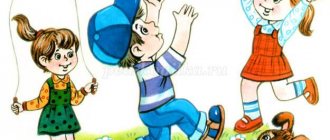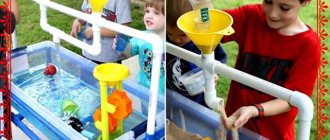Progress of the exercise:
The teacher shows the frame-insert and explains that “residents”
- geometric figures.
To close all the windows, you need to place the figures correctly, without leaving empty spaces in the windows. The teacher helps with folding, showing the trial and error method, and also draws the children's to the correct placement of the figures, while constantly approving the child's actions.
BUTTERFLY
didactic game for developing finger movements
Target:
• Teach children how to fasten buttons.
• Develop fine hand movements.
• Form a positive emotional attitude towards the game.
• Develop purposeful actions with objects.
• Form a holistic image of an object, composing the whole from parts.
• Learn to distinguish colors, focus in the game on color as a significant feature.
Equipment: Body parts of a butterfly cut out of cardboard and covered with fabric, trimmed with colored braid, a whole figurine of a butterfly made from the same parts (the parts are connected using buttons of various shapes)
.
Progress of the exercise:
The teacher invites the children to play the game “Fun Pencil”
and with its help, complete the drawing of objects, outline drawings, letters, shade images of various objects, etc.
TETRIS
correctional exercise for the development of logical thinking
Target:
• Learn to correlate planar figures with a model and in practical action with objects.
• Learn to use the trial method, discarding erroneous options and fixing the correct ones.
• Develop logical thinking by putting figures in a certain order and in specially designated tabs.
Equipment:
Frame – liner with six windows; geometric shapes of rectangular and square shapes of various sizes and colors.
Progress of the game:
The teacher places one of the ornaments and a set of colored caps in front of himself and the child, paying attention to their similarity. Then he explains how to assemble the ornament so that it turns out to be a beautiful design. At the same time, the teacher says: “I take the red cap, put it on the red circle.”
.
The child can independently try to assemble the ornament, placing a lid on the circle, saying: “I took this one,”
or after trying it on,
“I took it not like that
. During the game, the teacher must praise the child for choosing the right color.
Progress of the game:
The teacher shows the figure of a butterfly, examines it with the children, paying attention to individual parts: the head, wings of different sizes, the body, explains that the head is located on top, the body is under the head, the wings are on the sides. Then the teacher shows how to make the same butterfly, composing it from separate parts. First, he places all the parts correctly on the table, then fastens all the buttons, connecting all the parts together so that they do not fall apart. The teacher invites the children to make exactly the same butterfly, handing out a set of parts. Children gradually lay out the parts, making them into a whole under the supervision of an adult, then fasten the buttons. Then the children can play with the butterflies.
FIND YOUR MOTHER CHILDREN
didactic game for the development of auditory perception
Target:
• Expand and clarify the meanings of words - names of animals and words related to the way of life of animals.
• Learn to match baby animals with adult animals by description or selection method.
• Learn to identify animals based on the teacher’s story.
Equipment: Large cards with images of wild and domestic animals, birds: cows, foxes, horses, chickens, etc.; small cards depicting the young of these animals .
Progress of the game:
The teacher shows the children a box of semolina and explains that in addition to pencils, paints, and felt-tip pens, you can draw various figures, objects and images with your fingers. The teacher shows how to draw and how to easily erase the drawing. The work is carried out individually, while drawing from a model, joint drawing, and free creativity are possible
MY FRIEND, CHICKEN
correctional game to develop the ability to communicate with others
Target:
• Development of kinesthetic sensations.
• Developing the ability to cooperate with adults and come into contact with them.
• Learn to overcome disgust (to paints)
Equipment: Colored paints with a brush, toy chickens.
Progress of the game:
The teacher shows and talks about the purpose of each household item. Teaches how to use them, practices skills, gives clear instructions: “Turn off the lights.”
;
“Turn off the iron”
;
“Close the window”
, etc.
CIRCLE, COMPLETE, SHAD
corrective exercise to prepare your hand for writing
Target:
• Learn to perceive an object using a circling movement and use the resulting image in artistic activity.
• Learn to complete the drawing, creating an image.
• Development of fine motor skills of the hand.
• To form purposeful activity and perseverance in work.
Equipment: Sets of cards with unfinished objects, with the task of drawing horizontal lines, completing the drawing and tracing it along the contour, etc.
Progress of the game:
The teacher takes his sheet of cardboard and shows (or other animals) walks on the grass.
.
“Oh, it’s raining
,” he says, turns the sheet over and shows the children how to stretch the braid to make rain.
At the same time, he draws attention to the fact that the rain comes from top to bottom diagonally - and each braid is pulled into its own slots, they are all laid side by side. Then the teacher gives the children sheets of cardboard , and they use it to complete the task. After this, the teacher turns the sheet over and says: “It’s raining again, quickly hide your bunnies (or other animals)
.”
Hands out figurines of bunnies (or other animals)
. Children hide them under mushrooms.
PYRAMID
corrective exercise for the development of related actions
Target:
• Learn to correlate the holes of the rings with the rod.
• Develop visual-motor coordination when operating with both hands.
• Form direction of action and stability of attention.
• Activate ideas about color, consolidate the names of colors.
Equipment: Pyramids of different sizes and shapes.
Progress of the game:
The teacher invites children to learn how to tie bows or ribbons, shows how to do this, and gives each child a try. The game is played in stages until the child learns to first tie at the base, then fold a bow or ribbon in both hands and then only make the main knot.
LET'S DRESS A TOUCHED DOLL
didactic game for the development of manual motor skills
Target:
• Learn to thread a lace into a hole, first by imitation, then by model.
• Develop small movements, purposefulness of actions.
• Observe the direction of movement diagonally, horizontally (despite the discontinuity of the line)
.
• Form visual-motor coordination and spatial orientation.
• Create an emotionally positive attitude towards the game task.
Equipment:
A cardboard sheet with an image and in the shape of a doll - a tumbler, holes are made on the head of the tumbler and a blue cord is attached; Holes are made on the apron and skirt of the tumbler doll and red and green laces are attached to them.
Progress of the game:
The teacher shows a figurine of a tumbler doll, examines it with the children, and draws attention to individual parts of clothing: a scarf, a skirt and an apron. The teacher asks the children to help dress a tumbler doll. The teacher explains how to do this, threads the tip of the lace into the hole and laces the scarf, skirt, and apron separately. Children perform this task according to a model, by imitation, independently and according to verbal instructions.
DECORATE DOLL
didactic game for practicing practical actions
Target:
•Practice practical actions with objects: ribbons, hairpins, Velcro, buttons.
• Learn to correlate objects depending on their correct location.
• Learn to evaluate your actions and enjoy positive results.
• Develop fine motor skills.
Equipment:
A doll made from a plastic bottle; "wardrobe"
dolls - a skirt made of ribbons attached to the belt with Velcro and buttons, hairpins of various colors and shapes, ties - elastic bands for braids, bows.
Progress of the game:
Option 1: Children are given pyramids with caps. The teacher disassembles his pyramid and invites the children to do the same. Then he draws attention to the holes in the rings and shows how to put them on the rod. Children act by imitation: with one hand they hold the base of the pyramid, with the other (leading)
take the rings. The rings are strung in any order. If there are difficulties, the teacher helps using joint actions and a pointing gesture. When repeating the game, the position of the hands changes: the child holds the rod with the leading hand, and strings the rings with the other.
Option 2: Children are given two pyramids: one with a thick core and the other with a thin core. The rings of both pyramids are removed and mixed. Children must match the holes correctly to the correct rod. The teacher teaches how to make a choice by trial, each time correlating the size of the hole with the thickness of the rod.
Option 3: The material changes. Children are offered pyramids with compound rings of different sizes.
COLORFUL WORLD
didactic color perception game
Target:
• Develop a positive attitude towards the game and teach how to focus on color in the game as a significant feature.
• Learn to distinguish colors, focusing on their uniformity or heterogeneity when applied.
• Learn to denote the result with the words “such”
,
“not like that”
, teach to act by imitation.
• Learn to select the same colors by eye and then check.
Equipment:
Thick sheets of paper depict ornaments consisting of circles of different colors; colored plastic covers that match the colors of the ornament.






